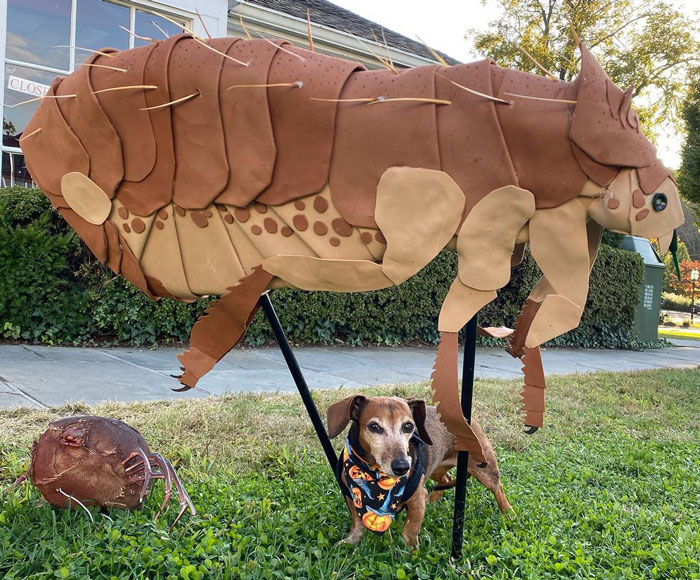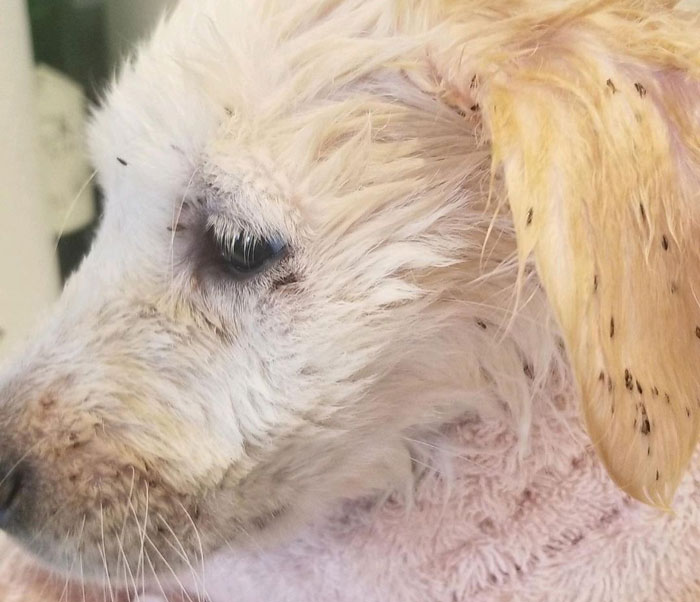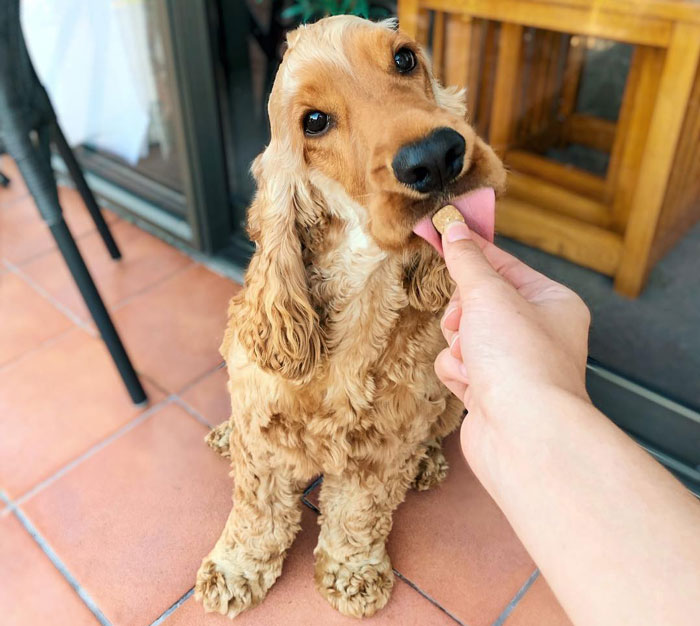Has your four-legged friend been scratching incessantly? Itching and discomfort are frustrating experiences for your dog, and as a pet owner, you want to get to the bottom of the problem as quickly as possible.
Fleas are a common culprit, and these tiny parasites can cause significant irritation to your beloved pet. But how can you be sure that fleas are the culprits?
Flea bites on dogs usually appear as small, red, raised bumps on the skin. You can find them in areas like the groin, belly, or the base of the tail.
In some cases, the bites can become inflamed or scabbed over due to excessive scratching. You may also find “flea dirt”, which looks like small dark specks of pepper, in your dog’s fur.
Identifying flea bites is just the first step. In this article, we’ll examine what flea bites look like on dogs and answer all your questions about treatment and prevention.
Let’s help your furry friend find comfort again.
The information provided herein is for informational purposes only. Please refer to ourdisclaimerfor more details..
Table of ContentsWhat Are Dog Fleas?What Flea Bites Look Like on DogsWhere Are Flea Bites Usually Found on Dogs?Differentiating Flea Bites from Other IssuesTreating Flea BitesSoothing the Itch: Home RemediesMedicated OptionsBeyond MedicationsHow to Prevent Flea Bites on DogsYear-Round Veterinary-Approved Flea PreventativesEnvironmental ControlHygiene PracticesCan Humans Get Fleas?Final Thoughts
What Are Dog Fleas?
Image credits:adventuresofbrowndog

While over 2,200 flea species exist worldwide, the most common culprit for flea problems in our canine companions is surprisingly the cat flea (Ctenocephalides felis). This versatile parasite infests over 50 different species of mammals and birds across the globe. In the United States, dogs, cats, various wild animals like foxes and raccoons, as well as domestic ferrets and rabbits, are all common targets for fleas.
Fleas are experts at remaining hidden, so you might not even realize your dog has a problem until they’re thoroughly uncomfortable. It’s important to be vigilant in checking your pet for these parasites.
What Flea Bites Look Like on Dogs
Image credits:

While flea bites on humans generally appear as obvious tiny red dots, identifying them on your dog can be more challenging due to their fur. But there are some telltale symptoms of flea bites.
The bites themselves look liketiny, red, raised dotson the skin. These bites are smaller than those from other insects and can become even more irritated and inflamed if your dog scratches at them. Some dogs have more severe reactions to flea bites, developing flea allergy dermatitis, developing a larger rash-like area of redness.
In extreme cases, persistent itching due to flea bites can lead to issues likescabbing, hair loss, and even open wounds on the skin.These open wounds or scabs can increase the risk ofsecondary infections.
It’s important to note that not all reactions are visible. We can also look forflea dirtwhich serves as additional evidence.Flea dirt, composed of dried blood from the bites, looks like littleblack or brown specksscattered throughout your dog’s coat. If you suspect flea dirt, place the specks on a damp paper towel. They will rehydrate and show their true color as reddish-brown remnants of the flea’s feeding.
Remember,only about 5% of a flea infestation actually lives on your dog. The other 95% (eggs, larvae, pupae) are spread throughout your home’s soft furnishings like reside in your carpets, bedding, and other areas of your home, making it important to treat both your pet and your living space for lasting flea control.
Where Are Flea Bites Usually Found on Dogs?
Image credits:ghettorescue

Fleas aren’t picky, but they certainly have preferred spots to feed on our canine friends. When checking your furry friend for bites, I recommend focusing on these prime flea-bite zones:
While these are the most common hotspots, remember fleas are opportunistic. If you suspect yourdog has fleas, a thorough full-body examination is the best approach.
The best way to find both fleas and flea dirt is with a fine-toothed flea comb. These combs are designed to trap these pesky critters and their droppings, making it easy to identify the source of your dog’s discomfort.
Differentiating Flea Bites from Other Issues
Pinpointing the exact cause of your dog’s scratching and discomfort can be tricky. Flea bites are a common culprit, but it’s essential to consider other potential sources. Here’s how to tell the difference:
If you can confidently rule out these other possibilities, there’s a strong chance your dog is dealing with fleas. However, diagnosing a flea infestation can be more complicated than it seems. Some dogs are highly allergic to flea saliva, reacting strongly even to just a few bites. In these cases, you might not see any live fleas or flea feces making the problem harder to detect.
Treating Flea Bites
Image credits:Zak Neilson

Once you’ve discovered the tell-tale signs of fleas on your dog, it’s time to focus on providing relief and preventing further discomfort. Here’s a breakdown of effectiveflea treatment options, ensuring we consider the best solutions for your beloved companion.
Soothing the Itch: Home Remedies
Medicated Options
Beyond Medications
It’s equally important to remember that treatment for fleas on dogs goes hand-in-hand with thoroughly treating your home and yard. This will break the flea life cycle of re-infestation and provide lasting comfort to your pet.
How to Prevent Flea Bites on Dogs
Image credits:lukaspaniel

Flea prevention on your dog is a multi-pronged approach that emphasizes year-round protection, environmental control, and good hygiene practices. Here’s a breakdown of the most effective ways to keep those pesky fleas at bay:
Year-Round Veterinary-Approved Flea Preventatives
Important Note:Consult your veterinarian to determine the best type and dosage of preventative for your dog based on their age, lifestyle, and any potential sensitivities.
Environmental Control
Hygiene Practices
Can Humans Get Fleas?
Yes, humans can get fleas.While fleas prefer animal hosts, they’ll readily bite humans if given the opportunity. Flea bites on humans are uncomfortable and itchy, and can sometimes even lead to secondary infections if scratched excessively. However, fleas cannot survive and reproduce on human blood, so infestations on humans are unlikely unless the source (typically a pet or infested environment) remains untreated. To get rid of fleas, treatment of both your pet and your home environment is important.
Final Thoughts
Discovering flea bites on your dog can be a frustrating and worrisome experience. However, understanding what flea bites look like, treating the bites, and taking effective preventative measures are key to ensuring your furry friend’s comfort and well-being.
Remember, the best defense against flea bites is year-round prevention. Consult your veterinarian to determine the most appropriate flea preventative for your dog, and follow their instructions carefully. By taking proactive steps, you’ll save your dog from the discomfort of those pesky parasites and help maintain a flea-free home.
2Kviews2Kviews
Pet Wellness